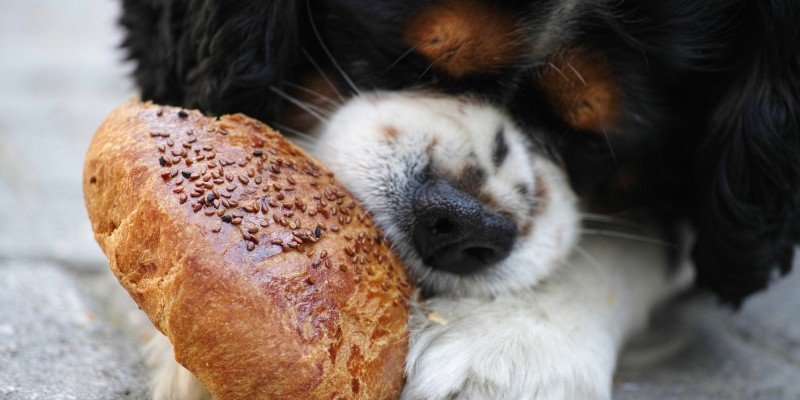I can’t count all the occasions I’ve noticed animals consume cakes, sandwiches, and even the whole bricks of bread. Bread is a crucial component of the American diet, and our pets seem to get their full share of it— but should they?
You might also like:
So, can dogs have bread?
The brief response is yes. In much the same manner as humans, dogs can consume bread — in moderation. Wheat and plain white are generally safe, as long as your dog doesn’t have any allergies, and usually feels fine after eating a bit of bread.
Giving your pup bread as a treat will not harm him or her as long as the rest of the pet’s diet is well balanced and packed with all the necessary nutrients.
Is bread good for dogs?
If your pup survives eating the bread doesn’t imply it’s necessarily great for him. It’s is mainly a filler meal and does not contain any specific and rare nutrients. Another thing to mention – bread is full of carbs that can bring your pet on the road to diabetes very quickly if you are not cautious enough with the size of the serving.
You might also like:

Is bread bad for dogs?
The bread itself is not generally poisonous, but there are exceptions. One of the – the bread dough or even underbaked bread. If you ever cooked it yourself you now that dough has to rise first and that’s where the yeast come handy. The perfect conditions for that process are hot, and humid, just like the insides of pup’s tummy.
Both the Merck Veterinary Manual and the American Society for the Prevention of Cruelty to Animals (ASPCA) list yeast dough as a very risky food for the dog. When that dough rises in a dog’s belly, it releases a poisonous amount of alcohol into the bloodstream of the dog. It also takes more and more space, which can trigger the bloating. But the real risk is from ethanol toxicosis. The symptoms might vary from moodiness, hypothermia, and weakness to seizures and even coma. All of these signs will start to occur from half an hour to two hours after your pup ate that dough. If you’ve spotted any at all, don’t hesitate and go to the vet! If untreated, the health of your dog will worsen quickly, and it can even cause death.
Another thing to note: checking that labels carefully before you feed your dog any human food (and canine food too, really). Unless your dog has an allergy to wheat, he or she probably won’t be harmed by a piece of white or wheat bread. But some bread has harmful components. All usual suspects, such as raisins that are often discovered in baked goods. Even a few raisins can create problems for your furry darling.
Garlic is another component discovered in bread that may be poisonous to animals. Some types of bread also have nuts and seeds that might seem excellent to humans because of their taste and nutritional value, but can be bad for dogs. The worst nut for your dog is macadamia, but due to high-fat content, even “okay” nuts and seeds can contribute to gut discomfort and pancreatitis.
Can dogs eat wheat bread?

Whole wheat bread regarded bread to be “healthier” because it provides our bodies with vital fibers and other nutrients that help our digestive system. However, even those “healthy” types of bread can become quite unhealthy when eaten in surplus.
Can dogs eat rye bread?

A small serving of the rye bread is unlikely to hurt your pet, although some animals have allergies to wheat and might also be sensitive to grains. It should not, however, become a cornerstone of your dog’s nutrition. It has minimum dietary importance for your animal. But as an occasional snack, it presents few dangers unless the health of your pet is already affected by some other factors.
Can dogs eat whole grain bread?

Instead of giving your dog white bread, the better option would be whole grain bread because it does not contain any components that could trigger health issues for your dog if fed in moderation. Add to that the reality that whole grain bread includes a proper quantity of nutritional fiber that might be helpful for your pet’s bowel movements, and you got the full picture. But again, remember the moderation rule.
My dog ate a loaf of bread. What do I do?
Even though baked bread is not poisonous–some animals can get very uncomfortable and experience a string bloating after overeating that bread. Sometimes in those cases, dogs need to be treated with medicines that cause vomiting.
We would suggest calling your doc and inform him or her how much your pet weights when he consumed that bread and how much the portion was. The vet can advise if you should be worried or not.
Dogs and bread. Summary
Bread’s glycemic index is high, and it’s also high in calories, so let your dog eat only the small portion of it to prevent obesity-related illnesses such as diabetes. Also check that your dog isn’t allergic to wheat, because if that’s the fact, the pup won’t be having a lovely time digesting it. Check bread’s ingredients, make sure it doesn’t contain any ingredients potentially toxic to your dog, like nuts, raisins, garlic, too much salt or sugar, etc. And make sure that whatever bread you feed your puppy, 95% of his diet should still consist of their regular, well-balanced dog food. Overall, dogs don’t have to consume anything that people do. In fact, they shouldn’t. If you want to increase your dog’s fiber intake, don’t switch to bread for it! Bread (regardless of the type) does more damage than good for dog’s diet.
Thanks for the blog graphics: Canva.com


